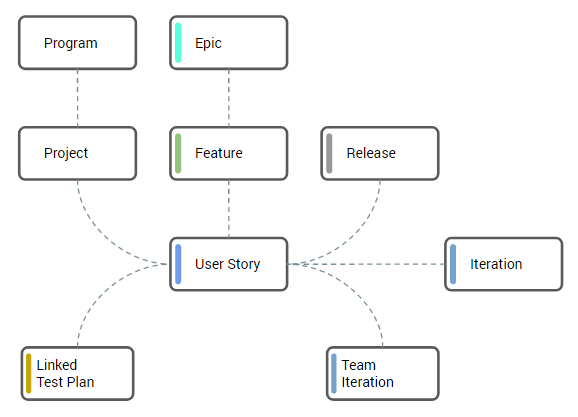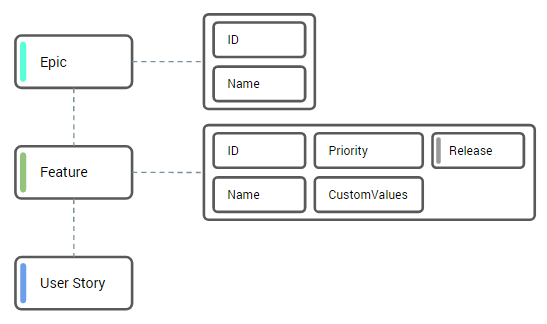Parent and Linked Entities
An entity in Targetprocess may have multiple parent and linked entities. Custom formulas support references to these entities and their properties. Access nested properties using dots.
EntityState.Name
Project.ID
Most common entity type is User Story. Here we'll describe how to refer to parent and linked entities in custom formula metrics used in custom fields at User Stories level.

Here is how to access basic properties of parent and linked entities at User Story level. Some of the formulas are valid for other entity types such as Bugs, Tasks, etc.
| Entity Types | Custom Formulas | Result Types | Result |
|---|---|---|---|
| User Story Bug | Feature.Name Feature.ID | Text Number | Fields of parent Feature |
| User Story Bug | Feature.Epic.Name Feature.Epic.ID | Text Number | Fields of parent Epic |
| Assignable Entities | Project.Name Project.ID | Text Number | Fields of parent Project |
| Assignable Entities | Project.Program.Name Project.Program.ID | Text Number | Fields of parent Program |
| User Story Bug Feature Epic | Release.Name Release.ID | Text Number | Fields of parent Release |
| User Story Bug Task | Iteration.Name Iteration.ID | Text Number | Fields of parent Sprint (Iteration) |
| User Story Bug Task | TeamIteration.Name TeamIteration.ID | Text Number | Fields of parent Team Iteration |
| Assignable Entities | LinkedTestPlan.Name LinkedTestPlan.ID | Text Number | Fields of linked Test Plan |

Use the formula below to inherit most commonly used values and properties from parent entities: Features and Epics.
| Entity Types | Custom Formulas | Result Types | Result |
|---|---|---|---|
| User Story Bug | Feature.ID | Number | ID of parent Feature |
| User Story Bug | Feature.Name | Text | Name of parent Feature |
| User Story Bug | Feature.FieldName Feature.CustomValues.Text("Field Name") | Text* | Value of Text Custom Field named "Field Name" of parent Feature |
| User Story Bug | Feature.FieldName Feature.CustomValues.Number("Field Name") | Number* | Value of Numeric Custom Field named "Field Name" of parent Feature |
| User Story Bug | Feature.BusinessValue.Name Feature.Priority.Name | Text | Business Value of parent Feature |
| User Story Bug | Feature.BusinessValue.Importance Feature.Priority.Importance | Number | Numeric importance of Business Value of parent Feature |
| User Story Bug | Feature.Epic.ID | Number | ID of parent Epic |
| User Story Bug | Feature.Epic.Name | Text | Name of parent Epic |
| User Story Bug | Feature.Release.ID | Number | ID of Release of parent Feature |
Access to custom field values is different for Metrics and Calculated Custom Fields
In formulas of Calculated Custom Fields to get value of Custom Field "Field Name" use:
FieldName
In formulas for Metrics to get value of Custom Field "Field Name" use:
CustomValues.Text("Field Name")
CustomValues.Number("Field Name")
CustomValues.Date("Field Name")
CustomValues.Boolean("Field Name")
Here is how you refer parent entities on different level of hierarchy: from Task to Program.

Any field and property of parent entities is supported
The examples below use .Name property as most frequently used one. Other fields, properties, collections are fully supported in the formulas as well.
| Entity Types | Custom Formula | Result |
|---|---|---|
| User Story Bug | Feature.Name | Name of parent Feature |
| User Story Bug | Feature.Epic.Name | Name of parent Epic |
| Task Bug | UserStory.Name | Name of parent User Story |
| Task Bug | UserStory.Feature.Name | Name of parent Feature |
| Task Bug | UserStory.Feature.Epic.Name | Name of parent Epic |
| Feature | Epic.Name | Name of parent Epic |
| User Story Bug Task Feature Epic Request | Project.Name | Name of parent Project |
| User Story Bug Task Feature Epic Request | Project.Program.Name | Name of parent Program |
Updated almost 7 years ago
